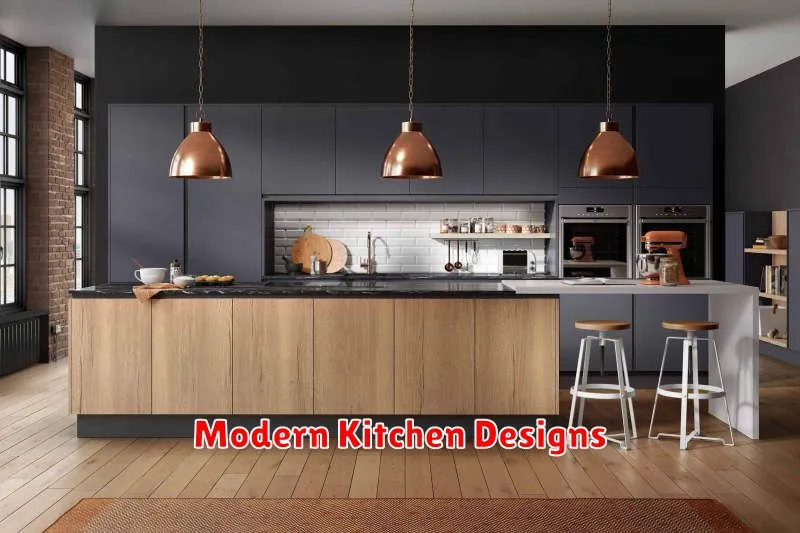Are you looking to revamp your kitchen and create a modern and stylish space? This article presents the top 10 kitchen inspiration ideas for modern homes, showcasing the latest trends in design, functionality, and aesthetics. From sleek minimalist designs to incorporating smart technology and maximizing storage solutions, we’ll explore innovative ways to transform your kitchen into a heart of your home that is both beautiful and efficient. Discover modern kitchen ideas that will inspire your next home renovation project.
Open Concept Kitchen
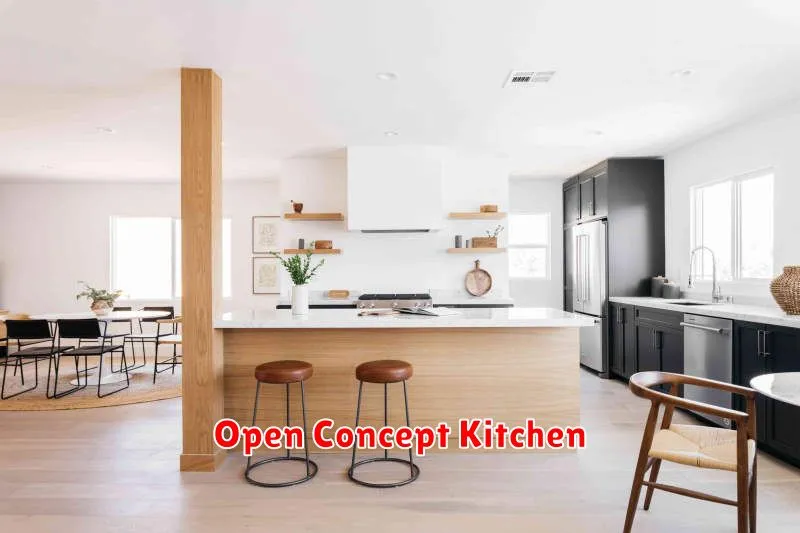
An open concept kitchen is a design style that integrates the kitchen seamlessly with adjacent living spaces, such as the dining room or living room. This eliminates physical barriers like walls, creating a more expansive and interconnected feel.
Key benefits of open concept kitchens include increased natural light, improved flow and interaction between spaces, and a sense of spaciousness, particularly beneficial in smaller homes. The design promotes a more social atmosphere, ideal for entertaining guests or simply enjoying family time.
However, potential drawbacks should be considered. Noise from kitchen appliances can be more readily heard throughout the home. Messes and odors are also more visible and spread more easily. Furthermore, careful planning is crucial to ensure sufficient storage and counter space to maintain a clean and organized environment, despite the open layout.
Design considerations for an open concept kitchen include careful selection of materials and finishes to maintain visual cohesion between the kitchen and adjacent areas. Consistent color palettes and flooring choices contribute to a unified aesthetic. Careful placement of appliances and cabinetry is also essential for efficient workflow and to avoid obstructing traffic flow.
Ultimately, the suitability of an open concept kitchen depends on individual lifestyle and preferences. While it offers many advantages in terms of spatial feel and social interaction, it also demands careful planning and consideration of potential drawbacks. Thorough planning, involving professional consultation if necessary, is strongly recommended to ensure a successful and functional design.
Two-Tone Cabinetry
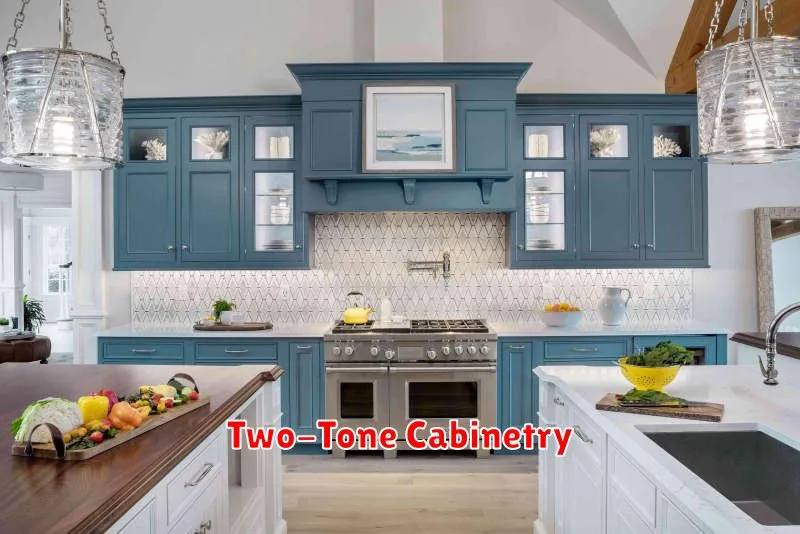
Two-tone cabinetry is a popular design trend that involves using two different colors or finishes on kitchen or bathroom cabinets. This creates a visually interesting and dynamic space, offering a departure from the traditional uniformity of single-color schemes.
The benefits of two-tone cabinetry are numerous. It allows for a greater degree of customization and personalization, enabling homeowners to reflect their unique style and preferences. It can also be used to highlight specific architectural features or create a sense of visual balance within the room. Furthermore, it presents an opportunity to incorporate contrasting colors or textures for a more sophisticated and layered look.
Choosing the right color combination is crucial for achieving a harmonious and aesthetically pleasing result. Popular choices include pairing a dark lower cabinet with a lighter upper cabinet to create a sense of grounding and visual height, or vice versa, for a more airy and bright feel. Consider the overall style of the room and the existing color palette when selecting your colors. Warm tones paired with cool tones, or analogous colors, can work exceptionally well.
Material considerations also play a significant role. The materials used for the cabinets, such as wood, laminate, or thermofoil, can greatly impact the overall appearance and durability. The chosen material should complement the colors and contribute to the desired aesthetic. The level of sheen, whether matte, semi-gloss, or high-gloss, should also be carefully chosen as it affects the way light interacts with the cabinets and the overall ambiance of the space.
Installation of two-tone cabinetry requires careful planning and execution. Professional installation is often recommended to ensure a seamless and high-quality finish. Proper measurement and precision cutting are critical to achieve a clean and polished look. The installation process should be coordinated with other aspects of the kitchen or bathroom renovation to minimize disruption and maximize efficiency.
In conclusion, two-tone cabinetry offers a versatile and stylish option for homeowners seeking to enhance the aesthetic appeal and functionality of their kitchen or bathroom. By carefully considering color combinations, materials, and installation, homeowners can create a truly unique and personalized space that reflects their individual style and preferences.
Industrial Style Setup
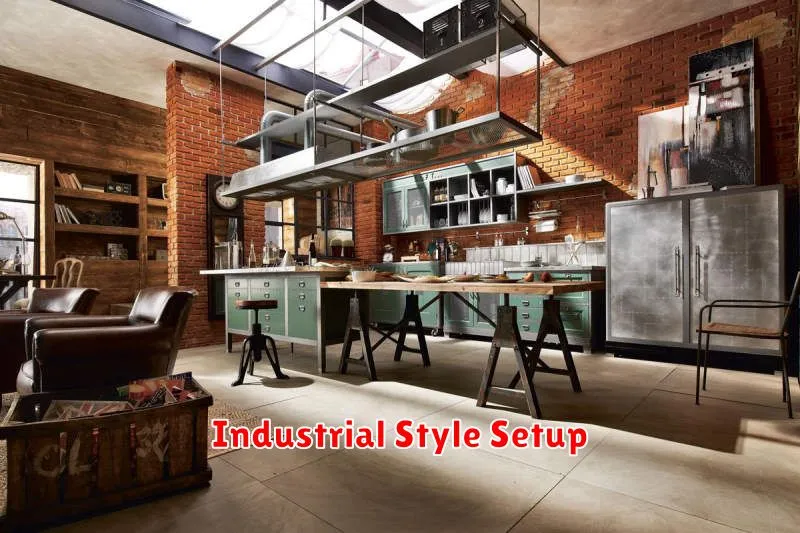
An industrial style setup evokes a sense of raw, unfinished spaces often found in converted factories or warehouses. Key characteristics include exposed brick, metal, and ductwork, creating a distinctly utilitarian aesthetic.
Materials play a crucial role. Think metal, particularly steel and iron, in furniture pieces like chairs, shelving, and lighting fixtures. Concrete floors or concrete-effect finishes are prevalent, while exposed brick walls add texture and character. The use of wood, often reclaimed or with a distressed finish, provides a warm contrast to the cold industrial elements.
Color palettes are typically muted and neutral. Shades of gray, brown, and black dominate, with occasional pops of color from accent pieces. The overall effect should be one of understated elegance, rather than stark coldness.
Lighting is a significant design element. Industrial-style pendant lights, often featuring exposed bulbs and metal cages, are a common choice. Strategic placement of lighting can highlight architectural features and create a dramatic ambiance.
Furniture should be functional and robust, reflecting the style’s origins. Metal chairs, industrial-style workbenches repurposed as desks, and simple, unadorned shelving units are all suitable choices. Avoid overly ornate or delicate pieces; the aesthetic prioritizes functionality and simplicity.
Accessories are carefully selected to complement the overall theme. Vintage or antique elements, such as maps, metal signs, or industrial tools, can add character and reinforce the industrial aesthetic. However, it is important to avoid overcrowding the space; intentional minimalism is crucial.
In conclusion, achieving a successful industrial style requires a careful balance of raw materials, muted colors, and functional furniture. The emphasis should be on creating a space that is both stylish and inviting, reflecting the unique blend of ruggedness and sophistication that defines this popular design aesthetic.
Compact Kitchen with Smart Storage
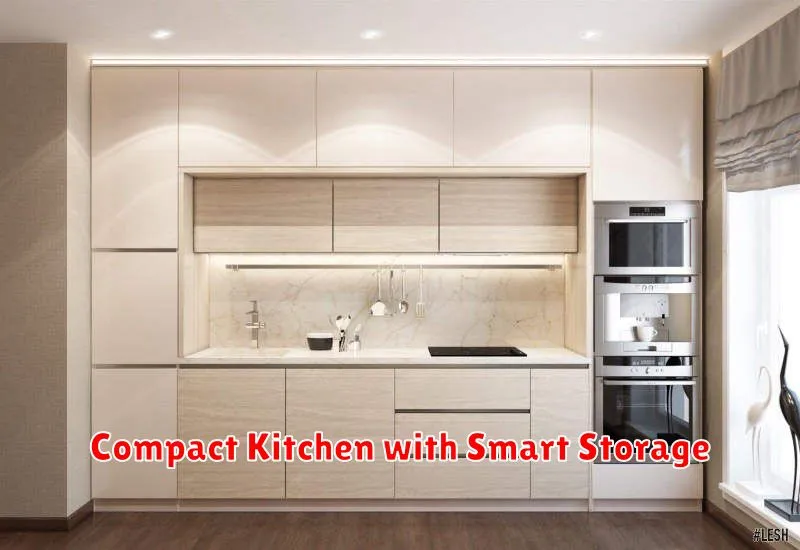
Designing a compact kitchen requires careful planning and creative solutions to maximize functionality and storage. Space limitations necessitate innovative strategies to ensure the kitchen remains efficient and aesthetically pleasing.
Smart storage is paramount in a small kitchen. This involves utilizing every inch of available space, employing vertical storage solutions like tall cabinets and ceiling-height shelving. Clever use of drawers, pull-out pantries, and corner units maximizes accessibility and minimizes wasted space. Think multi-functional furniture; for example, a kitchen island with integrated storage or a breakfast bar with drawers underneath.
The selection of appliances should also be considered carefully. Opting for space-saving appliances such as compact dishwashers, slim-line refrigerators, and microwaves built into cabinets can significantly improve the efficiency of the kitchen’s layout. Consider fold-away tables or wall-mounted tables that can be retracted when not in use to free up floor space.
Light colors and reflective surfaces such as mirrored backsplashes or glossy cabinets can create an illusion of more space. A well-planned lighting scheme, with both ambient and task lighting, is also crucial in enhancing the feeling of spaciousness and functionality. Minimalist design principles help reduce clutter and create a more open feel.
Careful consideration of work triangle efficiency, the relationship between the sink, stove, and refrigerator, is key. Maintaining a compact and efficient work triangle is crucial even in a smaller space to improve workflow and minimize unnecessary steps.
Ultimately, a successful compact kitchen design balances functionality, aesthetics, and efficient use of space. By implementing smart storage solutions, choosing the right appliances, and incorporating design principles that maximize the available area, even the smallest kitchen can be both stylish and highly functional.
High Gloss Finishes
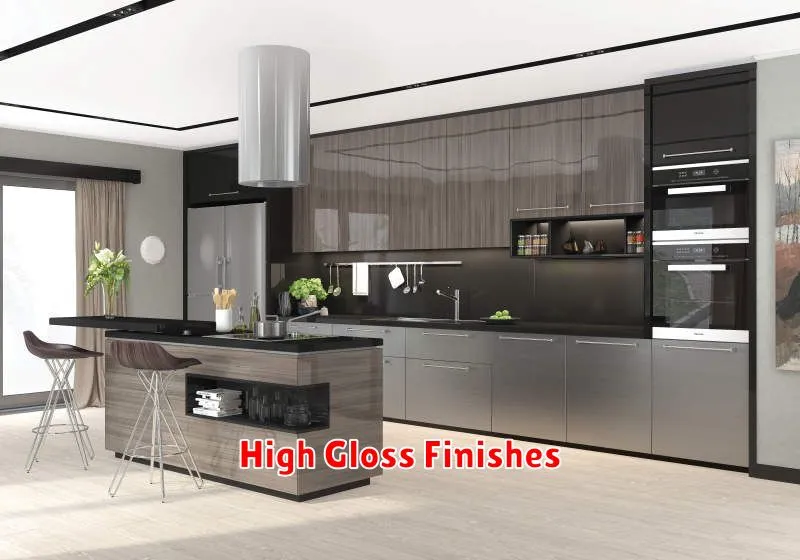
High gloss finishes are a popular choice for many surfaces, offering a sleek and modern aesthetic. They are characterized by their highly reflective surface, creating a polished and luxurious look.
Achieving a high gloss finish typically requires several coats of paint or varnish, each carefully applied and sanded smooth to create a flawless, mirror-like sheen. The process is more involved than achieving a matte or satin finish, requiring greater precision and attention to detail.
Durability is a key consideration. While a high gloss finish can look stunning, it can also show imperfections and scratches more readily than other finishes. Regular cleaning and careful maintenance are therefore essential to preserving its appearance.
The application method can significantly impact the final result. Spraying often yields the most even and flawless finish, although other methods, such as brushing or rolling, can be used with careful technique. The choice of paint or varnish is also crucial, with high-quality products being necessary to achieve a truly professional-looking result.
Different materials can be finished with a high gloss, from furniture and cabinetry to floors and walls. The specific requirements for achieving a high gloss finish will vary depending on the material being treated. Proper surface preparation, including cleaning and sanding, is always critical for optimal results.
Ultimately, the decision to use a high gloss finish depends on personal preference and the desired aesthetic. While it requires more effort and care, the resulting high-shine surface can add a touch of elegance and sophistication to any space.
Scandinavian Wooden Touch
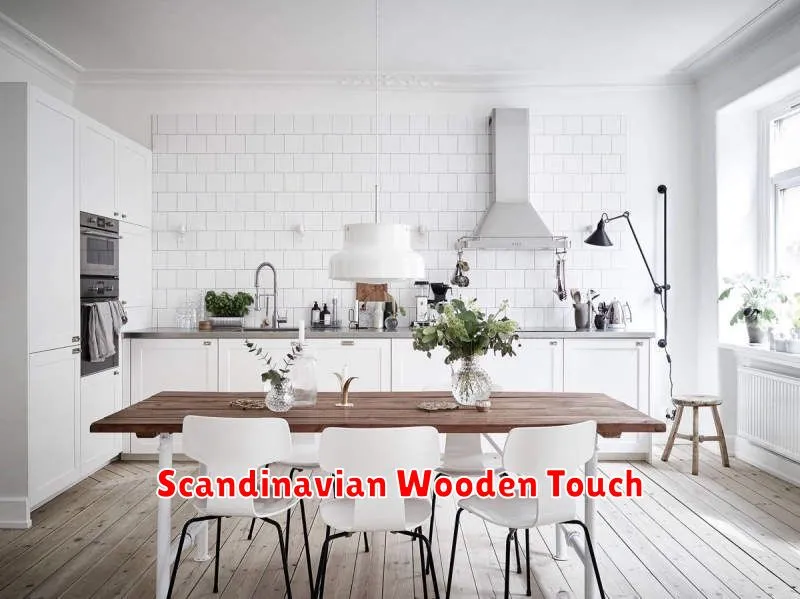
The Scandinavian design style is celebrated worldwide for its minimalist aesthetic and functional approach. A key element contributing to its unique charm is the extensive use of wood. This natural material brings warmth, texture, and a sense of understated elegance to any space.
Light woods, such as birch, pine, and ash, are particularly favored in Scandinavian interiors. Their pale tones create a bright and airy feel, reflecting light and enhancing the sense of spaciousness. This is especially beneficial in Nordic countries where sunlight is often limited during the winter months.
Beyond simply being aesthetically pleasing, the use of wood in Scandinavian design reflects a deep appreciation for natural materials and sustainability. Wood is a renewable resource, and its inherent beauty reduces the need for excessive ornamentation or artificial materials.
The craftsmanship associated with Scandinavian woodworking is also noteworthy. Often, furniture and other wooden elements are meticulously crafted with clean lines and simple forms, emphasizing the natural grain and texture of the wood itself.
Incorporating a Scandinavian wooden touch into your home doesn’t require a complete overhaul. Simple additions like a wooden coffee table, a set of wooden chairs, or even some wooden accessories can instantly transform a room, introducing a sense of calm and sophistication.
Whether it’s a rustic wooden shelving unit, a sleek wooden headboard, or a delicate wooden tray, the versatility of wood allows for seamless integration into various design schemes, maintaining the core values of Scandinavian simplicity and functionality.
Marble Countertops
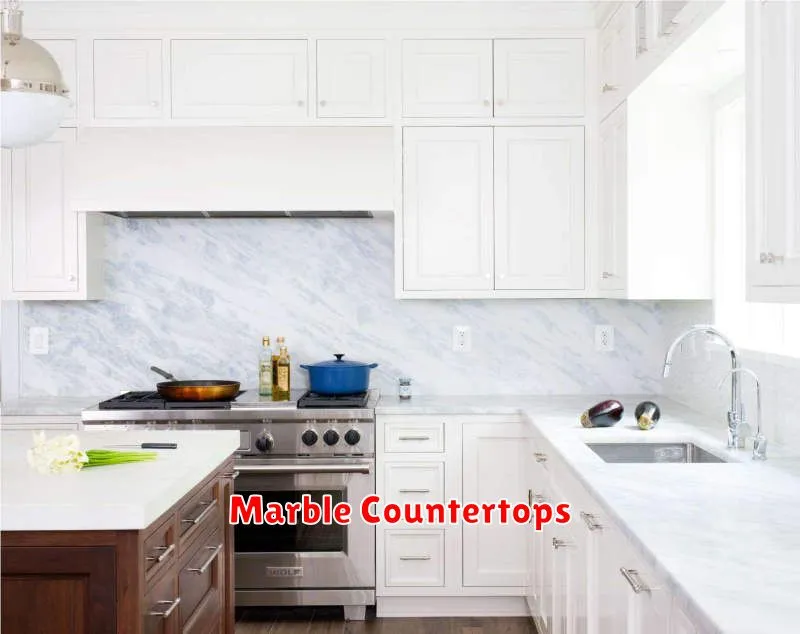
Marble countertops are a popular choice for homeowners seeking to add elegance and sophistication to their kitchens and bathrooms. Known for their luxurious appearance and unique veining patterns, marble offers a timeless appeal that elevates any space.
However, it’s important to understand that marble is a natural stone, and therefore comes with certain characteristics that require consideration. Its porous nature means it’s susceptible to staining if not properly sealed and maintained. Regular sealing is crucial to protect the stone from liquids like wine, juice, and oil.
Durability is another key factor to consider. While marble can last for decades with proper care, it’s relatively softer than other countertop materials like granite or quartz. This means it’s more prone to scratching and etching from acidic substances. Using cutting boards and trivets is essential to minimize damage.
Despite these considerations, the beauty and prestige of marble countertops are undeniable. The wide variety of colors and veining patterns available allows for customization to suit any design aesthetic. From classic white Carrara to dramatic Calacatta Gold, the options are vast.
Ultimately, the decision of whether or not to choose marble countertops depends on individual preferences and lifestyle. Weighing the pros and cons carefully, including maintenance requirements and potential costs, will help homeowners make an informed decision.
Cost is another significant factor. Marble countertops are generally more expensive than other countertop options. The price varies depending on the type of marble, its origin, and the complexity of the installation.
All-White Minimalist Design
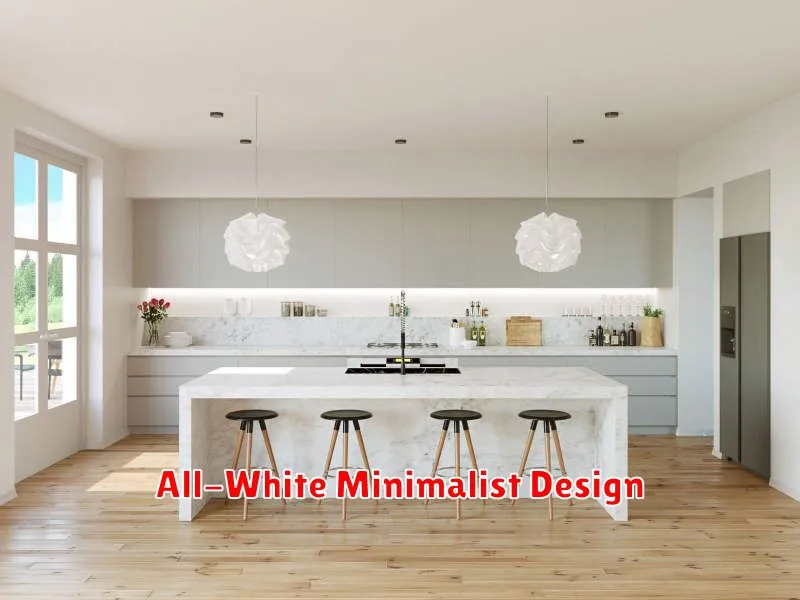
Minimalist design, particularly in an all-white palette, offers a clean and serene aesthetic. It prioritizes simplicity and functionality, eliminating clutter and unnecessary elements to create a sense of calm and spaciousness.
The all-white color scheme acts as a blank canvas, allowing light to reflect and enhance the feeling of openness. This makes it ideal for smaller spaces, where maximizing light is crucial. Different textures and materials can be introduced to prevent the space from feeling sterile.
Key elements of all-white minimalist design include clean lines, simple shapes, and a focus on natural materials. Think sleek furniture with uncluttered surfaces, natural wood accents, and perhaps the subtle addition of plants to add a touch of life.
Functionality is paramount. Every piece of furniture and decor should serve a purpose, contributing to the overall efficiency and ease of use of the space. Storage solutions are integrated seamlessly, ensuring that everything has its place.
While the overall look is minimalist, it’s not necessarily devoid of personality. The choice of materials, the subtle variations in texture, and carefully chosen accessories can add depth and character, preventing the space from feeling cold or impersonal. A well-executed all-white minimalist design is both stylish and incredibly practical.
Kitchen Island with Seating
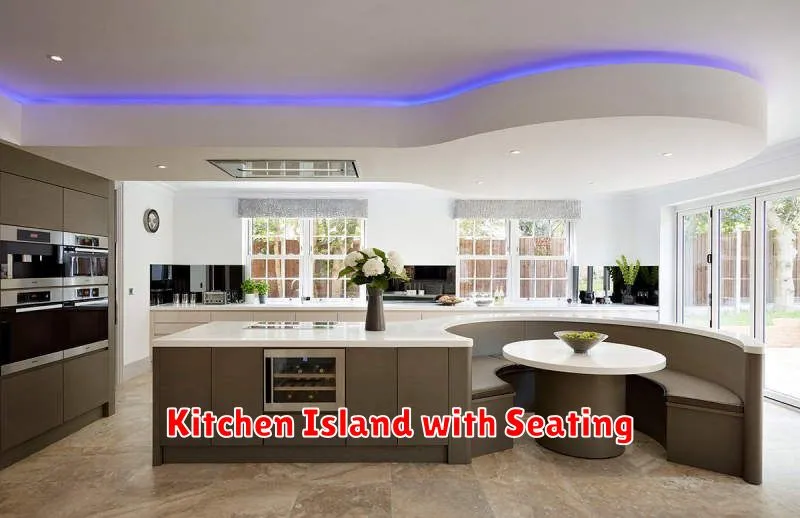
A kitchen island with seating is a highly desirable feature in many modern kitchens. It offers a blend of functionality and style, transforming the heart of the home into a more versatile and social space.
The primary benefit is the added counter space. Islands provide a significant expansion of prep area, allowing for multiple cooks to work simultaneously or ample room for spreading out ingredients. This extra space is invaluable for larger families or frequent entertainers.
Beyond practicality, the seating component enhances the kitchen’s social aspect. Whether it’s casual breakfasts, homework sessions, or informal gatherings, the island becomes a natural gathering point. The integrated seating eliminates the need for separate dining areas in smaller spaces, maximizing floor space.
Customization is another key advantage. Islands can be tailored to fit any kitchen’s style and size. Options abound, from materials like granite, quartz, or butcher block to varying sizes and shapes, ensuring a perfect match for your existing décor. You can even select the style of seating; from sleek bar stools to more comfortable cushioned chairs.
However, consider the space requirements. A kitchen island needs sufficient room for comfortable movement around it, ideally at least 42 inches of clearance on all sides. Careful planning is vital to avoid a cramped and inefficient layout. Budget is another important factor; high-end materials and custom designs can significantly increase costs.
In conclusion, a kitchen island with seating offers numerous benefits, enhancing both functionality and the overall aesthetic appeal of your kitchen. Careful consideration of your space, budget, and desired style will ensure that this addition transforms your kitchen into a true centerpiece of your home.
Colorful Backsplash Accents
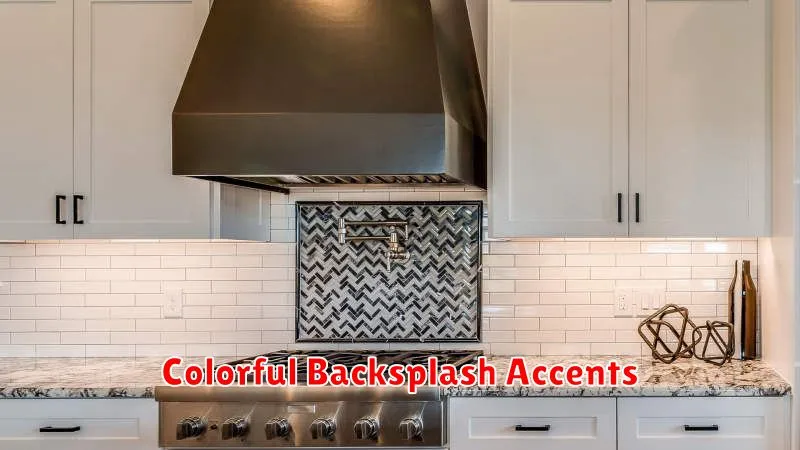
A backsplash is more than just a protective surface; it’s a key element in defining the style and personality of your kitchen or bathroom. Adding a splash of color with a vibrant backsplash can instantly transform the look and feel of the room, making it feel more inviting and energetic.
The options are virtually limitless when it comes to choosing a colorful backsplash. From the classic and timeless appeal of ceramic tiles in bold hues to the modern sophistication of glass tiles, there’s a perfect choice for every taste and budget. Consider the overall design aesthetic of your space when selecting your color palette. A bright, saturated color can create a focal point, while subtler shades can complement existing elements.
Material is another crucial consideration. Ceramic tiles offer durability and versatility, coming in a vast array of colors, patterns, and finishes. Glass tiles provide a sleek, modern look, and their reflective quality can make a small space feel larger. Natural stone, such as marble or granite, adds a touch of luxury and sophistication, though it can be more expensive and require more maintenance.
Don’t underestimate the power of pattern. A geometric pattern can add visual interest and texture, while a floral design can infuse a sense of elegance. Consider using a colorful backsplash as an opportunity to incorporate a unique pattern that reflects your personal style.
Ultimately, the best colorful backsplash for your space depends on your personal preferences and the overall design of your room. Take your time to explore the many options available and choose a backsplash that not only protects your walls but also enhances the beauty and functionality of your kitchen or bathroom. Remember to consider the lighting in your space as well, as this will affect how the colors appear.

